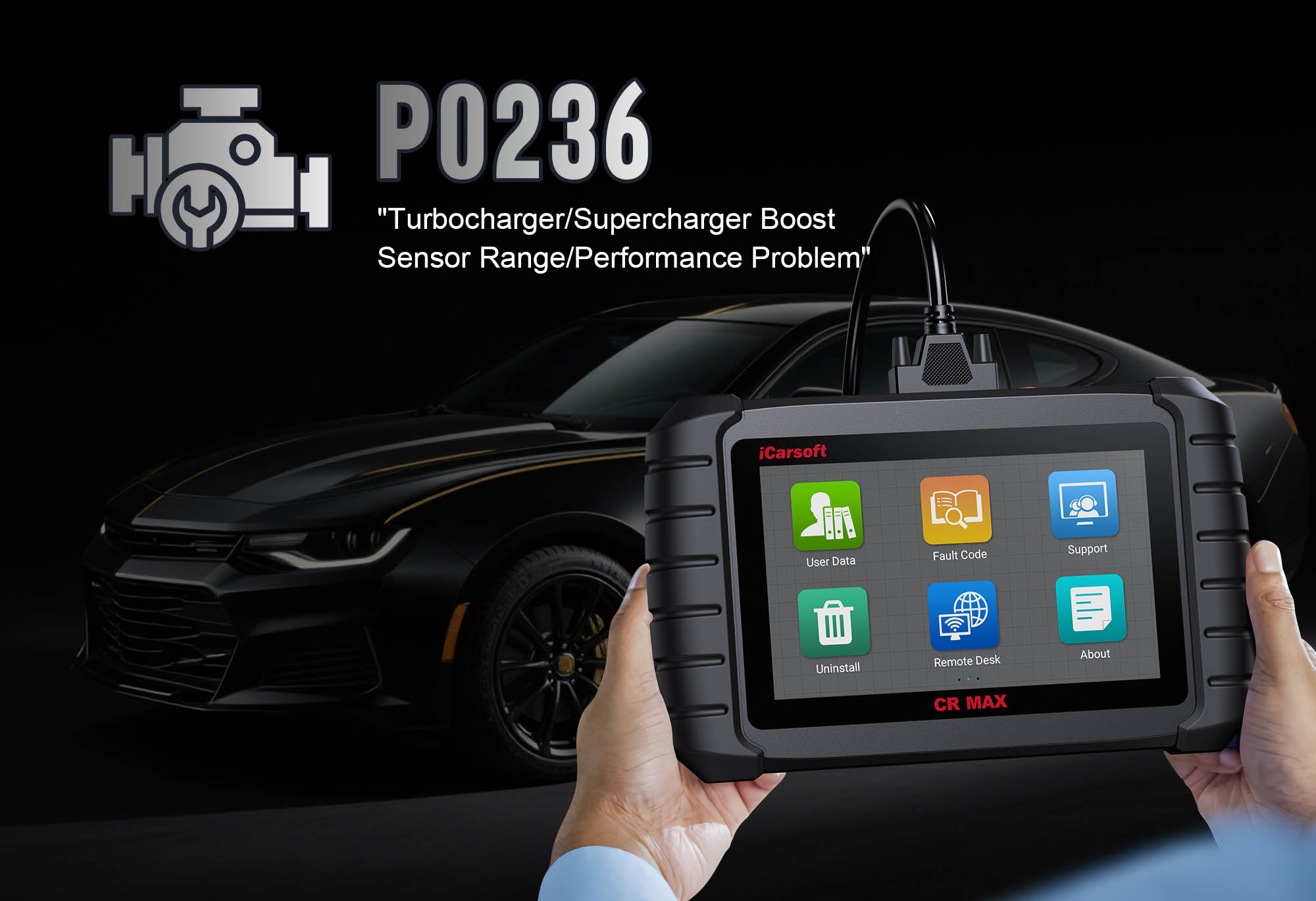How to Diagnose & Clear P0236 with iCarsoft CR MAX: Turbo Boost Sensor Fix Guide
If your check engine light pops on and a scan returns P0236, your turbocharged or supercharged vehicle is flagging a critical issue with its boost pressure sensor circuit. This generic OBD-II code translates to "Turbocharger/Supercharger Boost Pressure Sensor A Circuit Range/Performance," meaning the Engine Control Module (ECM) is receiving abnormal signals from the sensor that monitors compressed air pressure entering the engine.
The boost pressure sensor acts as the "eyes" of your turbo system. Mounted on the intake manifold or intercooler outlet, it measures air pressure (typically 0–30 psi) and sends a corresponding electrical signal (0.5V–4.5V) to the ECM. This data lets the ECM adjust fuel injection, ignition timing, and wastegate operation—ensuring the turbo delivers optimal power without overboosting (which can damage the engine). When P0236 strikes, the sensor’s signal is too high, too low, or unresponsive, leading to symptoms like laggy acceleration, reduced power, or even limp mode activation.
Basic scanners might only label P0236 as a "boost sensor fault" but can’t pinpoint whether the issue is a bad sensor, cracked vacuum hose, or failing turbo actuator. The iCarsoft CR MAX changes this with its turbo-specific diagnostics, real-time pressure monitoring, and vehicle-specific wiring diagrams. Let’s walk through how to use this tool to fix P0236 for good.
Why It Matters
Ignoring P0236 puts your turbo system and engine at risk of costly damage. The boost pressure sensor is critical for preventing "overboost"—a condition where excess compressed air floods the engine, causing detonation (knocking), melted pistons, or blown head gaskets. Even mild cases of P0236 lead to noticeable performance loss: turbo lag increases, horsepower drops (often by 20–30% in turbocharged vehicles), and fuel economy worsens as the ECM defaults to a "safe" rich fuel mixture. Over time, unregulated boost can also wear out the turbocharger’s bearings and seals, leading to a $1,000–$3,000 replacement. Addressing P0236 early with the CR MAX not only restores performance but also protects your vehicle’s most expensive components.
Understanding P0236: Causes & Key Symptoms
To diagnose P0236 effectively, start by recognizing its warning signs and root causes:
Common Symptoms of P0236
- Turbo Lag: The engine takes significantly longer to build power during acceleration (e.g., delayed response when merging onto highways).
- Reduced Horsepower: A noticeable drop in performance, especially at high RPMs—you’ll struggle to reach typical speeds or pass other vehicles.
- Check Engine Light + Limp Mode: The ECM often activates limp mode (limits power to ~50%) to protect the engine, making the vehicle feel sluggish.
- Erratic Idle: The engine may sputter, fluctuate, or stall at idle if the sensor’s pressure readings are unstable.
- Increased Fuel Consumption: Unreliable sensor data forces the ECM to use a richer fuel mixture, lowering efficiency by 10–15%.
Top Causes of P0236
| Cause |
Description |
| Faulty Boost Pressure Sensor |
Internal components wear out (common after 100,000+ miles), causing inaccurate voltage signals (e.g., stuck at 0.2V or 4.8V). |
| Vacuum/Pressure Leaks |
Cracked hoses, loose intercooler connections, or damaged intake manifolds let compressed air escape—throwing off sensor pressure readings. |
| Damaged Wiring/Connectors |
Corroded pins, frayed wires, or water intrusion in the sensor’s electrical connector disrupt signal transmission to the ECM. |
| Turbocharger Mechanical Issues |
A sticking wastegate, failing actuator (electric or vacuum-driven), or worn turbine blades can’t maintain proper boost pressure—confusing the sensor. |
| ECM Malfunction |
Rarely, the ECM fails to interpret sensor signals correctly (often fixed with a manufacturer software update or reflash). |
Why iCarsoft CR MAX Is Perfect for P0236 Diagnostics
Basic OBD-II scanners only flag P0236 as a "boost sensor fault," but the iCarsoft CR MAX is designed to diagnose turbo systems with precision—eliminating guesswork and unnecessary part replacements:
Real-Time Boost Monitoring
Displays live boost pressure (psi/kPa) and sensor voltage side-by-side, so you can spot abnormalities instantly (e.g., sensor stuck at 0.2V when it should hit 3.0V under acceleration).
Turbo Circuit Testing
Runs automated checks for the sensor’s 5V reference voltage, ground connection, and signal continuity—ruling out wiring issues in minutes (no manual multimeter needed).
Vehicle-Specific Turbo Diagrams
Preloaded with color-coded schematics showing sensor locations, vacuum hose routes, and wastegate wiring (e.g., 2023 Volkswagen Golf GTI, 2021 Ford F-150 PowerBoost).
Wastegate Actuator Tests
Manually activates the turbo’s wastegate to check for sticking or mechanical failure—critical for distinguishing sensor issues from turbo hardware problems.
Data Logging
Records boost pressure and sensor voltage during test drives, capturing intermittent P0236 triggers (e.g., issues that only occur at highway speeds) that static scans miss.
Auto VIN Detection
Automatically identifies your vehicle’s make, model, and engine type, ensuring you use the correct boost pressure parameters (e.g., 18 psi for a 2.0L turbo vs. 25 psi for a 3.0L turbo).
Step-by-Step: Diagnose P0236 with iCarsoft CR MAX
-
1. Connect the CR MAX & Confirm the Code
Plug the CR MAX into your vehicle’s OBD-II port (usually under the dashboard) and power it on. Select your vehicle via Auto VIN (fast and accurate) or manual entry (make/model/year). Navigate to Engine > Fault Codes > Read Codes to confirm P0236. Tap Code Details for vehicle-specific triggers (e.g., "BMW: Boost Sensor Signal Above 4.7V for 5 Seconds" or "Ford: Signal Below 0.4V During Acceleration").
-
2. Monitor Live Boost Data
The CR MAX’s live data reveals sensor behavior in real time. Go to Engine > Live Data > Turbo/Supercharger and select three key parameters:
- "Boost Pressure Sensor Voltage" (target range: 0.5V–4.5V)
- "Actual Boost Pressure" (compare to your vehicle’s specs—check the CR MAX’s Vehicle Specs tool for details)
- "Desired Boost Pressure" (ECM’s target pressure—should match actual pressure if the system works).
Start the engine and perform gentle acceleration (avoid full throttle to prevent overboost damage). P0236 is confirmed if voltage stays outside 0.5V–4.5V, or actual pressure doesn’t align with desired pressure.
-
3. Locate & Inspect the Boost Sensor
Use the CR MAX’s Component Location tool to find the sensor (typically near the intercooler outlet or intake manifold). Visually inspect for:
- Physical Damage: Cracks in the sensor housing or oil contamination (sign of a failing turbo seal).
- Loose Connections: Wiggle the sensor’s electrical connector—if voltage jumps on the CR MAX, it’s a loose or corroded pin.
- Vacuum Hose Issues: Check hoses attached to the sensor for cracks, dry rot, or disconnections (replace damaged hoses immediately).
-
4. Test the Sensor Circuit
Wiring problems often mimic a faulty sensor—use the CR MAX to rule them out. Navigate to Special Functions > Engine > Sensor Tests > Boost Pressure Sensor Circuit. Follow the tool’s prompts to run three critical tests:
- 5V Reference Check: Ensures the ECM supplies steady 5V to the sensor (failed = ECM or wiring issue).
- Ground Test: Verifies the sensor has a proper ground (resistance should be <0.5Ω).
- Signal Continuity: Checks for broken wires between the sensor and ECM (use the CR MAX’s wiring diagram to identify pin locations).
-
5. Check for Vacuum/Pressure Leaks
Leaks are the #1 hidden cause of P0236. With the engine off:
1. Disconnect the vacuum hose from the boost sensor.
2. Attach a hand pump to the hose and apply 5–10 psi of pressure.
3. Monitor "Boost Pressure Sensor Voltage" on the CR MAX.
- Leak Detected: Voltage drops rapidly (air escaping) or doesn’t rise with pressure—inspect intercooler, intake manifold, and all boost hoses for cracks.
- No Leak: Voltage stays steady—move on to testing the turbocharger.
-
6. Test the Turbocharger Wastegate
A sticking wastegate can’t regulate boost—use the CR MAX to test it. Go to Special Functions > Engine > Turbocharger Tests > Wastegate Actuator Test. The tool will manually activate the actuator (electric or vacuum-driven):
- Good Actuator: You’ll hear a click, and "Wastegate Position" on the CR MAX will change (e.g., from "Closed" to "Open").
- Bad Actuator: No movement or delayed response—clean the actuator (if vacuum-driven) or replace it (if electric).
-
7. Repair & Clear P0236
Fix the root cause based on diagnostics:
- Faulty Sensor: Replace with an OEM part (use the CR MAX’s Part Lookup—e.g., Bosch 0281002931 for many turbo models).
- Leaks: Replace cracked hoses or use high-temp silicone sealant for small intercooler cracks; tighten loose connections.
- Wiring Issues: Splice frayed wires with heat-shrink connectors; clean corroded pins with electrical contact cleaner.
Clear the code: Navigate to Engine > Fault Codes > Clear Codes to delete P0236.
-
8. Verify the Fix
Take a 30-minute test drive that includes city stop-and-go and highway acceleration (to stress the turbo). Use the CR MAX’s Data Logging to record boost pressure and sensor voltage—save the log for future reference. After driving, re-scan for codes: No P0236 + matching actual/desired boost pressure = successful repair!
Preventing P0236 Recurrence
Use the iCarsoft CR MAX to keep your turbo system healthy and avoid future P0236 errors:
- Quarterly Boost Checks: Run Engine > Live Data > Turbo/Supercharger scans to monitor sensor voltage and pressure—catch abnormalities early.
- Air Filter Maintenance: Replace air filters every 15,000 miles—debris can damage the boost sensor and turbocharger blades.
- Turbo Oil Changes: Use full synthetic oil (meets your vehicle’s specs) and change it on schedule—turbochargers rely on clean oil for lubrication and cooling.
- Inspect Hoses Regularly: Check vacuum/boost hoses during oil changes—replace them every 3–5 years (or sooner if cracked/dry) to prevent leaks.
- ECM Software Updates: Use the CR MAX’s One-Key Upgrade to install manufacturer patches that improve boost control and sensor signal interpretation.
Summary Table
| Step |
Action |
| 1 |
Connect CR MAX, confirm P0236, and review vehicle-specific code details |
| 2 |
Monitor live boost voltage/pressure to confirm abnormal sensor behavior |
| 3 |
Locate and visually inspect the boost sensor, connectors, and hoses |
| 4 |
Test the sensor circuit (5V reference, ground, signal continuity) |
| 5 |
Check for vacuum/pressure leaks using a hand pump and CR MAX |
| 6 |
Test the turbo wastegate actuator for sticking or failure |
| 7 |
Repair the root cause and clear P0236 |
| 8 |
Test drive, log data, and re-scan to verify the fix |
Final Thoughts
P0236 might seem like a "turbo mystery," but the iCarsoft CR MAX turns it into a solvable problem. Its ability to track live boost data, test circuits, and guide wastegate checks eliminates the guesswork that leads to expensive, unnecessary repairs—like replacing a turbo when the issue is just a cracked hose or faulty sensor.
Whether you’re a DIY enthusiast fixing your daily turbocharged car or a technician servicing a fleet, the CR MAX gives you the tools to resolve P0236 efficiently. By addressing the root cause (not just the code), you restore your vehicle’s performance, improve fuel economy, and protect its turbo system from long-term damage—saving time and money in the process.
FAQs About P0236 Code
Q: Can I drive my turbocharged vehicle with P0236?
A: Short-term driving (e.g., to a repair shop) is possible if you avoid hard acceleration, but long-term use risks engine or turbo damage. The ECM’s limp mode limits power, but unregulated boost can still cause detonation. Use the CR MAX to diagnose the issue within 1–2 days of seeing the code.
Q: How do I tell if P0236 is a sensor issue or a turbo issue?
A: Use the CR MAX’s wastegate actuator test: If the actuator moves correctly but boost pressure still doesn’t match desired pressure, it’s likely a sensor or leak. If the actuator doesn’t move, the turbo (or actuator) is faulty. The CR MAX’s live data also helps—sensor voltage outside 0.5V–4.5V points to a sensor/wiring issue.
Q: How much does it cost to fix P0236?
A: Costs vary by cause: Replacing a boost sensor = $50–$200 (DIY with CR MAX); fixing leaks = $20–$100 (hoses/clamps); replacing a wastegate actuator = $200–$500; replacing a turbo = $1,000–$3,000. The CR MAX helps avoid the most expensive fixes by identifying cheap-to-repair issues first.
Q: Why does P0236 come back after I clear it?
A: You likely didn’t fix the root cause. Common reasons: Unrepaired vacuum leaks (small cracks are hard to spot), corroded sensor pins (cleaning helps), or a failing turbo actuator (tests may miss intermittent sticking). Use the CR MAX’s data logging to capture when the code returns—this reveals patterns (e.g., only at high RPMs) that point to the issue.





